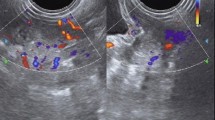Summary
A stable ring chromosome 21 was found in an azoospermic man with an otherwise normal phenotype. Meiotic studies in another known azoospermic male with r(21) had indicated that breakdown of spermatogenesis resulted from pairing failure of chromosome 21, followed by degenerative changes in the chromosomes, before the cells had completed the first meiotic division. While primary sterility was a constant feature in the three adult males, eight healthy females with r(21) were fertile. However, they were at risk for Down syndrome and spontaneous abortions.
Similar content being viewed by others
References
Cabrol C, Werner-Favre C, Wyss M, Pitmon D, Engel E (1983) Acute lymphoblastic leukemia in two children with a congenital chromosome anomaly: familial inv(11)(p15q13) in one and ring chromosome no. 21 in the other. Cancer Genet Cytogenet 8:67–74
Cachiero NLA, Russell LB, Swartout MS (1974) Translocations, the predominant cause of total sterility in sons of mice treated with mutagens. Genetics 76:73–91
Chandley AC (1979) The chromosomal basis of human infertility. Br Med Bull 35:181–186
Chandley AC (1981) The origin of chromosomal aberrations in man and their potential for survival and reproduction in the adult human population. Ann Génét (Paris) 24:5–11
Croquette MF, Couturier J, Dutrillaux B, Turleau C, de Grouchy J (1979) Présence chez un homme stérile de deux inversions péricentriques des chromosomes (9): inv(9)(p11q1209),inv(9) (pter→q1209). Ann Génét (Paris) 22:53–56
Ford CE (1970) Genetics activity of sex chromosomes in germinal cells. Philos Trans R Soc Lond [Biol] 259:53–55
Forejt J (1979) Meiotic studies of translocations causing male sterility in the mouse. II. Double heterozygotes for Robertsonian translocations. Cytogenet Cell Genet 23:163–170
Forejt J, Gregorovà S (1977) Meiotic studies of translocations causing male sterility in the mouse. I. Autosomal reciprocal translocations. Cytogenet Cell Genet 19:159–179
Hendry WF, Polani PE, Pugh RCB, Sommerville IF, Wallace DM (1976) 200 infertile males: correlation of chromosomes, histological, endocrine and clinical studies. Br J Urol 47:899–908
Howell RT, McDermott A, Gardner A, Dickinson V (1984) Down's syndrome with a recombinant tandem duplication of chromosome 21 derived from a maternal ring. J Med Genet 21:310–314
Huret JL, Leonard C, Kanoui V (1985) Ring chromosome 21 in a phenotypically normal but infertile man. Clin Genet 28:541–545
Joseph A, Thomas IM (1982) A complex rearrangement involving three autosomes in a phenotypically normal male presenting with sterility. J Med Genet 19:375–389
Kleczkowska A, Fryns JP (1984) Ring chromosome 21 in a normal female. Ann Génét (Paris) 27:126–127
Kosztolànyi G, Osztovics M, Tòth S, Kiss P, Nagy A, Pap M, Timàr T, Dobos M, Körner H, Degen D, Prütz D, Federlein F, Hickman G (1985) Sixteen cases with ring autosomes. Phenotype and karyotype. A collaborative study. Clin Genet 28:443 (abstr)
Léonard C, Bisson JP, David G (1979) Male sterility associated with familial translocation heterozygosity: t(8;15)(q22;p11). Arch Androl 2:269–275
Lifschytz E, Lindsley DL (1972) The role of X-chromosome inactivation during spermatogenesis. Proc Natl Acad Sci USA 69:182–186
Matsubara T, Nakagome Y, Ogasawara N, Oka S, Yocochi T (1982) Maternally transmitted extra ring(21) chromosome in a boy with Down's syndrome. Hum Genet 60:78–79
McIlree ME, Tulloch WS, Newsam JE (1966) Studies on human meiotic chromosomes from testicular tissue. Lancet I:679–682
Palmer CG, Hades ME, Reed T, Kajetin J (1977) Four new cases of ring 21 and 22 including familial transmission of ring 21. J Med Genet 14:54–60
Pui CH, Williams DL, Scarborough V, Jackson CW, Price R, Murphy S (1982) Acute megakaryoblastic leukaemia associated with intrinsic platelet dysfunction and constitutional ring 21 chromosome in a young boy. Br J Haematol 50:191–200
Rhomberg K (1984) Ring chromosome 21 in a healthy woman with three spontaneous abortions. Hum Genet 67:120
Richer CL, Fitch N, Sitahal S, Murer-Orlando M, Jean P (1981) Analysis of banding patterns in a case of ring chromosome 21. Am J Med Genet 10:323–331
Schmid W, Tenconi R, Baccichetti C, Caufin C, Schinzel A (1983) Ring chromosome 21 in phenotypically apparently normal persons: report of two families from Switzerland and Italy. Am J Med Genet 16:323–329
Stetten G, Sroka B, Corson VL, Cantù CD (1984) Prenatal detection of an unstable ring 21 chromosome. Hum Genet 68:310–313
Author information
Authors and Affiliations
Rights and permissions
About this article
Cite this article
Dallapiccola, B., De Filippis, V., Notarangelo, A. et al. Ring chromosome 21 in healthy persons: different consequencies in females and in males. Hum Genet 73, 218–220 (1986). https://doi.org/10.1007/BF00401230
Received:
Revised:
Issue Date:
DOI: https://doi.org/10.1007/BF00401230




